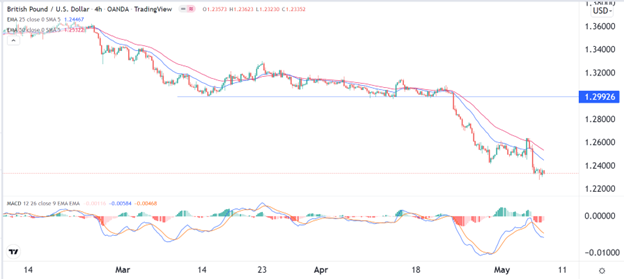Bearish View
- Sell the GBP/USD pair and set a take-profit at 1.2200.
- Add a stop-loss at 1.2412.
- Timeline: 1-2 days.
Bullish View
- Set a buy-stop at 1.2412 and a take-profit at 1.2500.
- Add a stop-loss at 1.2350.
The GBP/USD pair dropped to a multi-year low last week after the dovish rate hike by the Bank of England (BOE). It also declined as the strength of the US dollar continued after the FOMC decision and the US NFP data. It is trading at 1.2335 ahead of the important UK and economic numbers.
BOE Decision Dovish Tone
The GBP/USD pair declined after the Fed and BOE decisions. On Wednesday, the Fed maintain its hawkish tone when it delivered its interest rate decision. The bank decided to hike interest rates by 0.50%, the highest increase since 2000. It also signaled that it will not only hike interest rates by 0.50% in the coming meeting but also start its quantitative tightening process.
The Bank of England also concluded its meeting on Thursday and decided to hike interest rates by another 0.25%. That was its fourth straight interest rate hike since December last year. In its statement, the bank said that more rate hikes were necessary even as it warned about a recession. This was seen as a more dovish statement than expected.
The GBP/USD will have an eventful week as the Office of National Statistics is expected to publish the latest UK GDP data on Thursday. The data is expected to show that the economy slowed down in the first quarter as consumer spending declined. The ONS will also publish the latest industrial and manufacturing production numbers.
The other important data to watch will be the latest US consumer inflation numbers that will come out on Wednesday. Economists expect these numbers to show that the CPI eased slightly from 8.5% to 8.1% in a sign that inflation was easing. The core CPI, which excludes the volatile food and energy products, declined from 6.5% to 6.0%.
GBP/USD Forecast
The four-hour chart shows that the GBP/USD pair declined to a low of 1.2284, which was the lowest level in more than a year. On the four-hour chart, the pair managed to move below the important support at 1.2420, which was the lowest level on April 28. The pair has managed to move below the 25-day and 50-day moving averages. The MACD has moved slightly below the neutral level.
Therefore, the pair will likely keep falling today considering it has formed a small bearish flag pattern. If this happens, the next key support will be at 1.2200.

